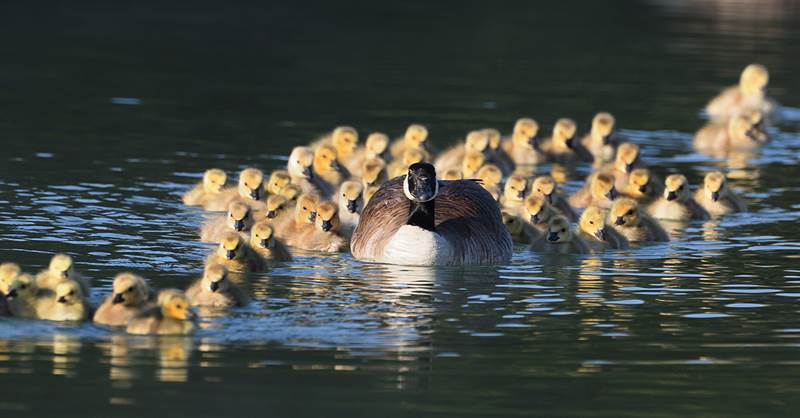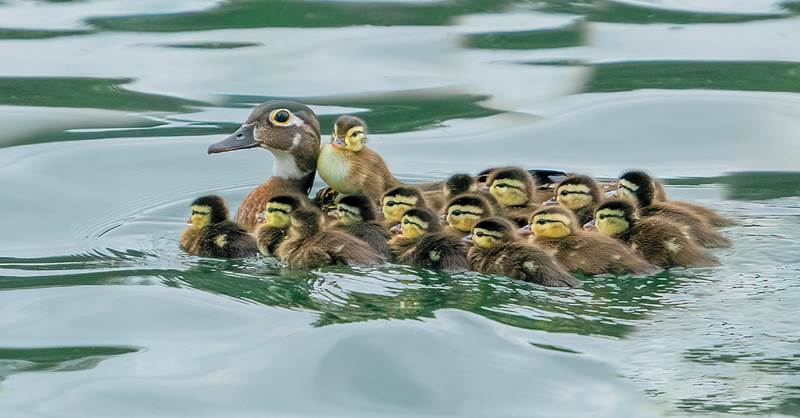Understanding Waterfowl: Super Broods
Amalgamations of ducklings and goslings can include offspring from two or more females
Amalgamations of ducklings and goslings can include offspring from two or more females
By Kali Rush and John M. Coluccy, PhD
.jpg)
If you live in waterfowl country, you have probably seen plenty of duck broods following single file behind hens, and goose broods being attended by both parents. Most waterfowl broods consist of a dozen or fewer offspring hatched from eggs produced by their biological mother. But have you ever seen 15, 20, or even 40 or more ducklings or goslings in a single brood? How about broods containing the progeny of more than one waterfowl species? This behavior, in which the offspring of two or more females are raised together in one group, is called brood amalgamation. The super-sized broods that result from this phenomenon are often referred to as creches or gang broods.
Two forms of brood amalgamation occur among North America's waterfowl. In pre-hatch brood amalgamation, one female lays her eggs in the nest of another female, who then raises the offspring along with her own. In post-hatch brood amalgamation, a female abandons or loses her young to another female, or two or more broods merge and are cooperatively cared for by more than one adult. Brood amalgamation is surprisingly common in waterfowl. In fact, it has been documented in 41 species of ducks, geese, and swans.
How big can these amalgamated broods get? In common eiders, as many as 60 ducklings have been observed in a single brood. Canada goose creches can exceed 100 goslings. Who takes care of these outsized broods? In the case of ducks, one hen is often left to raise all the ducklings on her own. But in some situations, two or more broods may congregate in a creche under the supervision of several hens. Among eiders, some of the hens take turns watching ducklings while other hens feed and preen. The babysitting females are known as "aunts." Two or more pairs of geese often adopt a similar arrangement when caring for their goslings.

Amalgamated broods can include the young of the same waterfowl species, which is known as intraspecific brood amalgamation, or the young of two or more species, which is known as interspecific brood amalgamation. The former is more commonly associated with post-hatch brood amalgamation, while the latter is more prevalent in pre-hatch brood amalgamation.
Prehatch brood amalgamation is largely the result of nest parasitism, in which females lay eggs in the nests of other females, who raise the offspring along with their own. Nest parasitism is especially common among cavity-nesting and colonial-nesting waterfowl, where the high density and visibility of nests make it easier for parasitic females to find and lay eggs in the nests of other females. Several waterfowl species—including canvasbacks, wood ducks, ruddy ducks, hooded mergansers, and snow geese—lay eggs parasitically, but the behavior is especially common in redheads. In one study conducted on Manitoba's Delta Marsh, more than 90 percent of canvasback nests contained redhead eggs. The most prolific nest parasite in the avian world is the brown-headed cowbird. Cowbird eggs have been found in the nests of more than 200 different host species, ranging from hummingbirds to raptors.
Post-hatch brood amalgamation is also more likely to occur in areas with high nest densities as well as in areas with limited brood habitat, where large numbers of recently hatched young come in close contact with each other. Even in these situations broods usually must be disrupted for mixing to occur. This can happen when young waterfowl wander off and become separated from their parents while feeding. However, brood mixing most often occurs during aggressive interactions between adults or after a predator attacks, scattering parents and their young. When the adults and young regroup, they may form amalgamated broods. In some cases, older or "super broody" females attract and accept young from subordinate females, who may ultimately abandon their broods.

There are several hypotheses about why brood amalgamation occurs among waterfowl and other birds. One is that survival of young is higher in large, amalgamated broods, which provide greater protection from predators and access to food supplies. Another is that parents improve their own probability of survival by sharing the demands of brood-rearing with other adults, which increases their reproductive output.
The loss and degradation of wetland habitats pose a serious threat to waterfowl in areas where they breed and nest. That's why Ducks Unlimited works with its partners to conserve high-quality habitats on breeding landscapes and in many other important areas for waterfowl across North America.
Kali Rush is a regional biologist and Dr. John Coluccy is director of conservation planning in DU's Great Lakes/Atlantic Region.
Ducks Unlimited uses cookies to enhance your browsing experience, optimize site functionality, analyze traffic, and deliver personalized advertising through third parties. By continuing to use this site, you agree to our use of cookies. View Privacy Policy